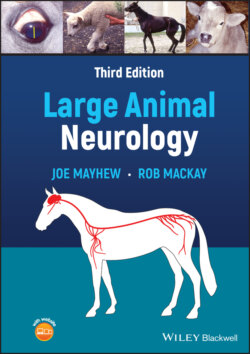Читать книгу Large Animal Neurology - Joe Mayhew - Страница 62
Electrodiagnostic testing
ОглавлениеElectroencephalography (EEG), needle electromyography (EMG) (Figure 3.2), quantitative EMG, and nerve stimulation and conduction testing contribute to a complete neurological evaluation. The techniques are used in large animals52–63 and are the same as those used in small animal neurology.64–66 An ambulatory EEG system has been described that allows telemetric recording from freely moving horses.67 Considerable experience in using these ancillary aids is required to be able to interpret electrophysiologic studies in large animals because findings in normal animals are not well defined.6068–70 This fact, and the expense of the equipment, makes these procedures rather out of reach for most large animal clinicians. However, visual evoked, brainstem auditory evoked, and other evoked potential testing (Figure 3.9) definitely have become more widely used in large animal neurology over the last decade or so, and references can be consulted for techniques and initial methods of interpretation.71–84
Certainly, the reasonably innocuous testing for transcranial magnetic and electrical motor evoked potentials (Figure 3.10) now has received attention in large animal neurology,85,86 and it appears to be a very sensitive and quite specific electrophysiologic test for the disruption of somatic motor pathways in disease states.87–89 This and the additional use of more elaborate but error‐prone quantitative EMG investigations58,60,62,70 should allow more accurate identification of neuromuscular disorders.
Finally, measuring conduction velocity across the cauda equina can be simply performed by using one stimulating electrode placed over the dura mater at the lumbosacral space and another stimulating electrode in the sacrocaudal cauda equina, with anode in adjacent skin. Induced motor action potentials are recorded using electrodes in a ventral coccygeal muscle. No conduction from the cranial stimulating site, with some potentials recorded from the caudal site early in a case of a fractured sacrum, can reasonably be taken as the cauda equina being totally severed. In this context, measuring the maximal bladder contraction pressure and maximal urethral closure pressure is a technique90 that should assist in better defining the site of a lesion and should particularly assist in monitoring the use of drugs that can be used to treat patients suffering from urinary incontinence. Of note is the fact that there appears to be discrepancies in reported normal values.90 However, the measurement of intravesicular and urethral pressure profiles could well be useful in monitoring horses with urinary incontinence.91,92
